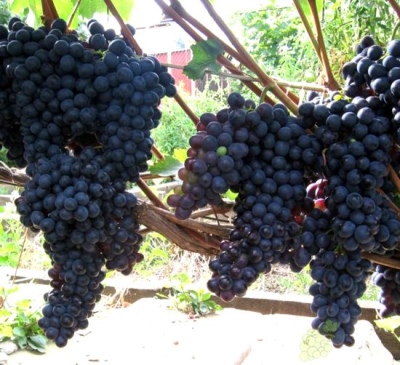
- Authors: Institute of Viticulture "Vierul", Moldova
- Appointment: dining room
- Berry color: Navy blue
- Taste: harmonious, thorny-cherry, when ripe cherry is fully ripe
- Ripening period: mid-late
- Ripening period, days: 130-135
- Frost resistance, ° C: -26
- Name synonyms: T-6-13
- Bunch weight, g: 500-1000
- Flower type: functionally female
Miner is a table grape variety that is in demand both in private households and on farm plots. The popularity can be explained by undemanding care and good yield.
Breeding history
The Shakhtar variety was obtained at the Moldovan Institute of Viticulture "Vierul".
Description
The bush is distinguished by strong growth, power, it is able to withstand heavy loads. A vine 3 cm thick ripens well. The number of fruiting shoots reaches 60-80%.
Ripening period
The miner belongs to varieties with a medium late ripening period. The first berries can be enjoyed in 130-135 days.
Bunches
The shape of the bunches is cylindrical-conical, they are dense and medium-dense, the mass of one reaches 500-1000 g.
Berries
The fruits are dark blue in color, round or slightly oval in shape. Their weight is 6-7 g, and their size is 24.5x22.3 mm.
Taste
It is a table variety that is well suited to fresh consumption. Berries taste - thorny-cherry, sugar content - 170-180 g / dm³, acidity - 7-8 g / dm³. The flesh is fleshy and the skin is firm. Grapes with such flavoring qualities are also suitable for technical purposes.
Yield
The variety is distinguished by high productivity, the average yield is 160 c / ha.


Growing features
The Shakhtar variety is distinguished by its undemanding soil composition, but if there is a choice, it is better to give preference to black soil. If the groundwater is less than 2.5 m deep, it is important to arrange drainage before planting. Before planting, it is recommended to cut the seedlings by 10 cm and dip them in a clay mash. And you can also increase the immunity of young shoots through the substance "Argumin".
Landing
Planting is carried out in early spring or November. The landing algorithm is as follows:
dig a hole 0.8 m in diameter and 0.8 m deep;
put the compost mixed with fertile soil on the bottom, and leave it in this form for a week - this will allow the soil to sink;
bury the seedling in the hole and cover it with soil;
water the landing site, one copy requires 10-12 liters of water;
add a layer of mulch;
adhere to the landing pattern of 1.5x2.5 m.

Pollination
The Miner variety has a functionally female type of flower, which means that additional pollinating plants are required for a good harvest. Nevertheless, according to the observations of some gardeners, sometimes the variety is able to cope on its own, it is not inclined to peas.
Pruning
It is customary to produce medium pruning - 6-8 eyes.The bush is able to withstand a heavy load, although in general the variety is not characterized by overloading in bunches. In this regard, rationing is not required, but it is advisable to systematically thin out the clusters. Greater efficiency can be achieved when the bush is kept on large formations or in an arched way.

Watering
If the summer is dry, then the bush should be moistened once a week. It is better for watering to dig out recesses in a circle and pour two buckets into them. And also the presented variety responds well to drip irrigation. It is important not to forget about moisture after a snowless winter and in mid-June.


Top dressing
Fertilize the bush three times per season:
at the beginning of the growing season, feed the culture with a mixture of superphosphates, ammonium nitrate and potassium salt in proportions of 20: 10: 5 g, respectively, diluted in 10 liters of water;
the same composition is suitable as additional nutrition before flowering;
after harvesting, potash dressings will be relevant, contributing to an increase in frost resistance.
Experienced growers are advised to bring organic matter for digging every two to three years; manure with the addition of ash, superphosphates and ammonium sulfate is suitable.
Frost resistance and the need for shelter
The miner is able to withstand frost down to -26 degrees, if you first protect it. Without shelter, frost resistance is limited to –21 degrees. The advantage of the variety is its high ability to regenerate, which means that even when freezing out, the plant will quickly recover.
When a crop is sheltered for the winter, it is more likely to be affected by rodents. Therefore, it is recommended to use spruce branches as a shelter. The lapnik should be placed under the vine so that it does not come into contact with the soil - this will not only scare off mice and rats, but also protect against mold.

Diseases and pests
Variety Miner is characterized by medium resistance to powdery mildew and gray mold, resistance to mildew is estimated at 3.5 points. As a preventive measure, it is enough to spray the culture with special agents against the fungus 2-3 times during the growing season.
The skin of the fruit is dense, which means that the wasps are not afraid of the plant. To protect the bush from other insects, you should periodically inspect it for damage, eliminate the affected areas in a timely manner, and systematically process the plants.

If a grape is exposed to any disease or insect, this always affects its appearance.
Storage
The disadvantage of the variety is the poor preservation of the harvest on the vine, so it is important to harvest ripe fruits on time. Fresh berries are not suitable for long-term storage, but they can boast of good transportability due to their dense skin.











































































